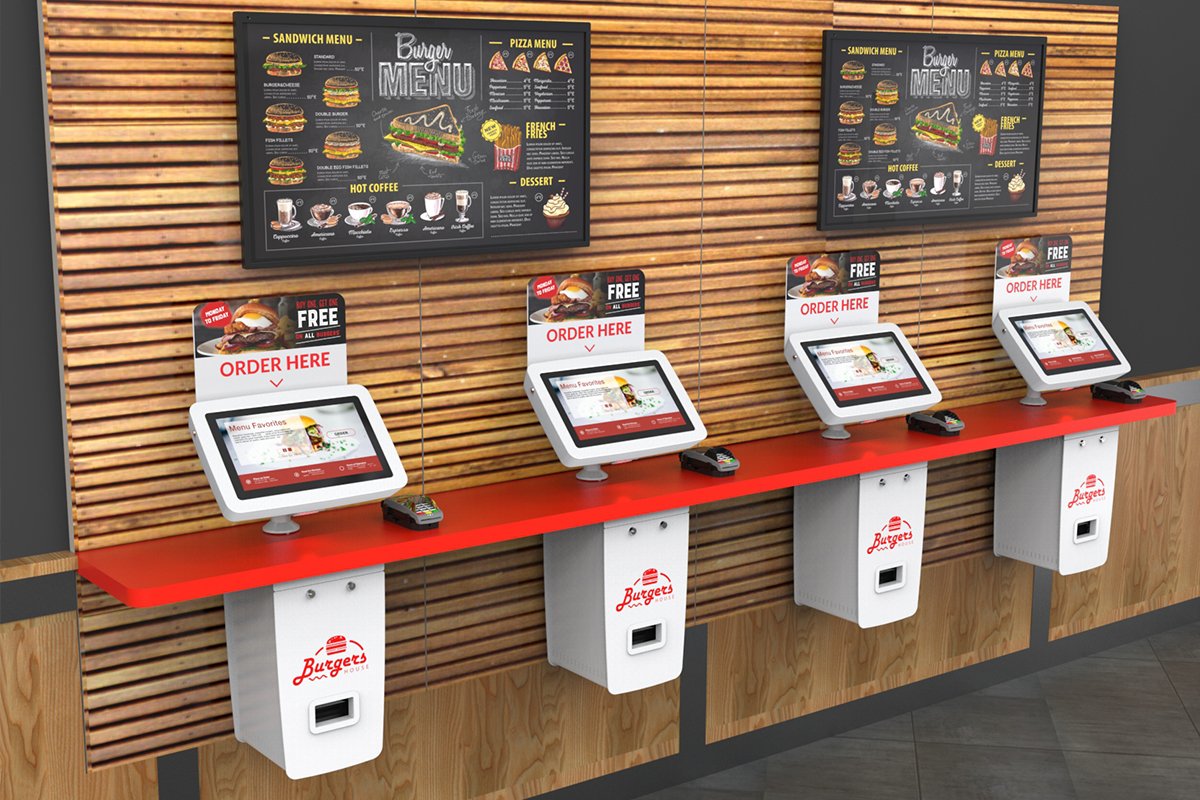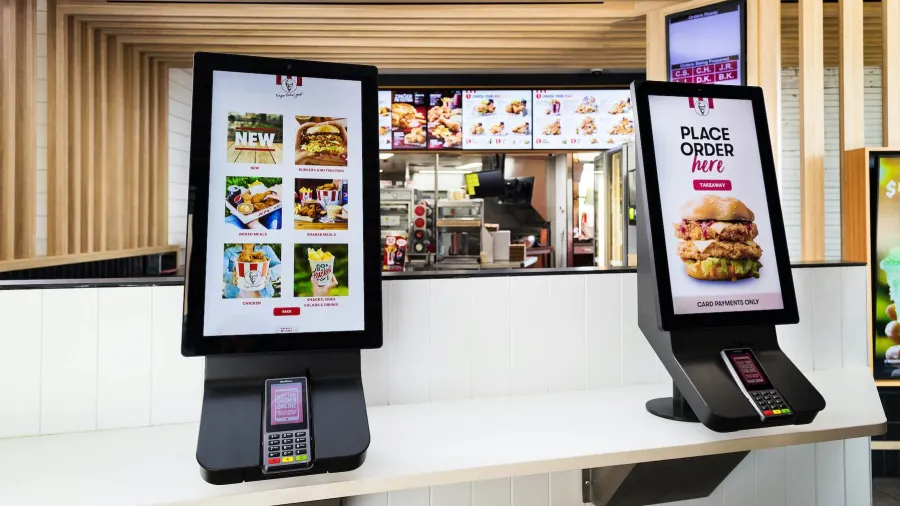
Restaurant Self-Ordering Kiosks Explained: Complete Guide & Practical Tips
In the fast-paced world of food and drink (F&B) and retail, technology keeps changing the way businesses work and interact with customers. Self-ordering kiosks are one of the new technologies that are changing the way customers place orders and businesses run their operations. Customers are back on-site now, and they expect digital experiences that are just as smooth as the ones they have with technology every day. A new standard for how restaurants should run has come about because of how people act. People say that the market for self-ordering kiosks will be worth about $30.8 billion in 2024.
This blog will talk about how restaurant self-ordering kiosks and systems work, what features they need, what benefits they offer, and how to make them work better for customers.
What are self ordering kiosk for restaurants?
A self-ordering kiosk is a self-service kiosk that has a food ordering system installed. It enables customers to place an order, confirm it, and pay for it all through the screen without the help of a server or cashier. The entire menu, events, or advertising are shown to the customer on this tiny, free-standing physical object. Restaurant owners can choose from a variety of self-service kiosk types, including wall-mounted and standalone models, based on the size of their establishment.

Self-order kiosks: Types and Cost
| Standalone Kiosks | These freestanding units are perfect for busy areas like ordering counters or restaurant entrances. |
| Wall-Mounted Kiosks | Perfect for businesses with limited space, wall-mounted kiosks offer a sleek and compact solution. |
| Tabletop Kiosks | Compact and versatile, tabletop kiosks are ideal for smaller dining settings or personalized ordering. |
| Outdoor Kiosks | Outdoor kiosks have weatherproof displays, reinforced casings, and modern payment systems. |
| Customized Kiosks | Custom kiosks incorporate branding, complex software, and bespoke designs for specific businesses. |
Each type serves different purposes, and understanding your business layout and customer flow can help you select the right option.
When determining self-order kiosk costs, include hardware, software, and installation. Installation and setup may cost more for larger kiosks. Companies charge $1,000+ for installation and delivery.
Should restaurants buy self-order kiosks? This self-order kiosk is worth the money for your business. Low cost lets you start receiving orders without spending thousands on a complicated system. Your POS system can start producing money right now.
Many companies have found self-order kiosks worthwhile. For self-ordering, we cooperate with several restaurants.
How do self ordering kiosks benefit restaurants?
Improved client satisfaction
Shorter wait times: Self-order kiosks provide a quicker and more convenient ordering experience by doing away with the need to wait in huge lines.
Personalization: Whether changing ingredients or selecting dietary restrictions, customers may easily personalize their orders.
24/7 accessibility: In establishments that are open around-the-clock, ordering kiosks guarantee that patrons can place orders even during off-peak times when personnel may be scarce.
Efficiency in operations
Staff allocation is optimized: By automating the ordering process, employees can concentrate on meal preparation and customer care, which boosts productivity.
Error reduction: Kiosks reduce errors brought on by misunderstandings by letting users enter their requests directly.
Making decisions based on data
Customer insights: Improved menu planning and marketing tactics are made possible by having access to real-time data on customer preferences and order trends.
Monitoring performance: By identifying peak hours, analytics help organizations allocate resources efficiently.
Growth in revenue
Opportunities for upselling: Astute suggestions for combos or add-ons entice clients to spend more money.
Savings: Companies can drastically cut labor expenses by lowering their reliance on front-end employees.
Why Are Self-Ordering Systems Essential for Multiple Locations?
These systems address chain restaurants’ labor shortages, operational inefficiencies, and service speed. Automating restaurant ordering improves operations and personnel efficiency. This way:
- Allows understaffed teams to relax.
- Improves processes by streamlining daily tasks.
- Reduces wait times and errors, improving diner satisfaction.
- Lets personnel focus on customer service and kitchen tasks.
- Improves business efficiency with fewer personnel.
How does the food ordering kiosk work?
To understand how a food kiosk works, consider someone ordering food from the digital menu on the touch screen.
When clients walk inside the restaurant, they can look at the digital menu and learn about the cuisine. They can then freely choose whichever dishes they want and tailor how many dishes they need in sequence. The 3D structure face camera, barcode scanner window, NFC module, and thermal printer enable customers to pay with a face/QR code/NFC card and print the receipt after the transaction is completed. Once the order is placed, it is immediately sent to the kitchen and synced with the restaurant’s POS system. Customers can return to their seats and await the dinner.

How To Choose The Right Self-Order Kiosk?
When choosing the ideal kiosk, it is important to consider functionality, pricing, and long-term worth. Here is a step-by-step guide.
- Evaluate your company’s needs: Determine your objectives, such as lowering wait times, increasing accuracy, or improving the client experience.
- Prioritise integration: Ensure that the kiosk works seamlessly with your existing POS, CRM, and inventory systems.
- Emphasis on usability: Look for an intuitive design that appeals to clients of all ages and levels of technological proficiency.
- Assess scalability: Choose a solution that can expand with your company, adding more features or kiosks as needed.
- Consider support and maintenance: choose dependable after-sales service and monthly software updates.
How to maintain a self ordering kiosk?
Your kiosks must need routine care and maintenance in order to function at their best:
- Examining hardware: Examine parts such as payment systems, printers, and touchscreens for wear and tear.
- Update your software frequently to improve operation and uphold security standards.
- Regular cleaning: To keep card readers and touchscreens hygienic and functional, clean them often.
- Proactive troubleshooting: To prevent interruptions during busy times, take quick care of minor problems.
FAQ
What are the benefits of self-service kiosks?
Self-service kiosks are significant because they improve the customer experience, lower labor costs, generate income through upselling, provide useful data for personalization, improve accuracy, accessibility, minimize human error, and provide organizations with adaptability and flexibility.
What is the average self-order kiosk price in 2025?
The average self-order kiosk pricing in 2025 will be between $2,500 and $7,500 per unit, depending on hardware quality, software features, and support. For restaurants want sophisticated reporting, payment integration, and a branded user interface, the cost may be greater.
How does a self-service kiosk for restaurants work?
A self-service kiosk in a restaurant allows customers to explore the menu, modify their orders, and pay without the need for human help. These kiosks work with your POS system to eliminate errors, improve service, and expedite kitchen operations.











